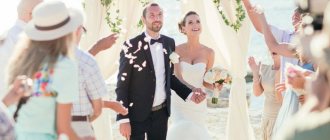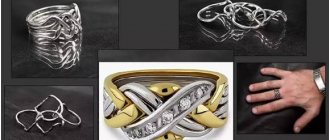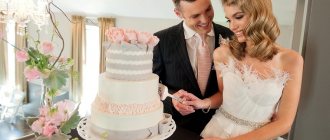Necessary equipment for a wedding photographer
Share this article:
Every beginner or experienced photographer at some point has the thought of making money through wedding photo shoots creeping into their minds. The profit there looms real, but the expenditure of effort and time is not so much. In addition, the collection of cats, walls and sunsets is already quite decent, processing skills have been honed, and a basic set of equipment is available. Today, wedding photography is considered the second most profitable, after advertising, and seems like an easy task for beginners. That is why numerous photographers, having a “DSLR” that costs half the average salary, are rushing to join the ranks of experienced wedding photographers.
The content of the article:
The first thing beginners need to know is that a wedding is a rather complex subject for filming. It’s an important day for newlyweds and a new family, and you simply have no right to ruin it with low-quality photos. And without the necessary set of equipment, it is better not to start such shooting. Some beginners hire a second photographer for a nominal fee, or even without it. But the level of responsibility is minimal and you can “shoot” filters or a spare battery from a colleague. The only downside to shooting in the background is that all the staging work takes place according to the first photographer’s idea.
Stages of a wedding
A classic wedding in our country, excluding individual wishes and national characteristics, consists of two parts: staged photography and reportage. The first includes a walk and small moments at the banquet. Here you can bring ideas to life, set light, poses, look for decorations and locations, and invite guests. At a banquet there is often a photo wall or a tradition of taking pictures with the newlyweds during the celebration. The remaining parts of the shooting are classified as reportage, because the photographer does not decide anything, but is only obliged to depict what is happening as much as possible. Typically this includes:
- Getting ready for the bride and groom, recently it has become fashionable to shoot in photo studios, hotels and specially rented apartments;
- Redemption with competitions or scripts, despite the change in fashion, many couples continue to hold them, especially not in cities;
- Registration and the way to the registry office, getting out of the car and much more, an outdoor ceremony in nature or in a beautiful place in the American style is gaining popularity;
- Walking, bridges, monuments and other popular rituals, here too, strong changes have occurred over the past 10 years - young people prefer to go to nature, to business centers or cafes;
- The banquet, starting from arrival at the place of celebration, ending with the fireworks and seeing off the guests, can last from a couple of hours to a couple of days;
- Many couples postpone their wedding until the next day or spend it instead of going for a walk; today in churches they allow photography during the ceremony.
In addition to the standard stages, young people may want absolutely any event: a trip to the cinema or to the football field, a trip to visit elderly relatives, visits to work or memorable places, even trips to the cemetery to the graves of close relatives. All points need to be discussed in advance in order to know what equipment will be needed. The photographer should know the schedule better than anyone else and think through the work in advance.
Necessary equipment
Having an approximate scenario in hand, you can decide on the necessary set of equipment and tools. Shooting in nature will require one set from you, registration and a banquet will require another, helicopter flights or extreme parachute jumps are a separate matter. Experienced photographers know by heart the contents of a travel “suitcase” with a minimum set. And beginners need to know what is required at a wedding:
- Naturally, the camera itself. No one will take pictures with a phone or a point-and-shoot camera.
- The required set of lenses, or one universal one.
- Tripod for camera stabilization.
- Flash standard, removable or pulsed light.
- Replaceable memory cards, batteries with reserve.
- Reflectors.
- A special bag for proper storage of all equipment.
If there is such a set, then any weather or situation is not scary. In addition to the above, you can take filters, diffusers, decorative and artistic elements, a spare camera in case the main one breaks down, and others. It is impossible to provide for all possible force majeure events, but the basic set will fully cover the situations of an average wedding.
Camera
The main load is placed on the camera, so the greatest demands are placed on it. For reportage photography, definitely choose a digital camera; film has a number of disadvantages and is not suitable for weddings. The price of consumables for the “film” will most likely exceed the budget for the entire wedding, the time between frames is much longer than the figure, and digitization, processing and printing will take a much longer time. Save your film camera for leisurely studio or landscape photography.
As for the system, a DSLR is much more suitable in many respects, but is more expensive. If your budget allows it, then buy a camera with a full-size sensor and without a crop factor, this way you will save time and effort on processing, and there will be much more high-quality, highly detailed material.
- Camera manufacturers have models in almost any price category that can be called “universal”, capable of shooting even in difficult conditions. For example, in poor lighting, in motion without significant loss of quality.
- It is best to choose a wide-format camera with the ability to change lenses. If we take the minimum requirements, we can highlight the ability to shoot in RAW, a resolution of at least 8 megapixels, the absence of noise at ISO 800, and ease of navigation. In general, it doesn’t matter what brand your camera is, or how high the values of the output parameters are, if you don’t know how to use it. Thoroughly study the menu and technical capabilities, switch modes and set white balance, for example, you should intuitively, without looking at the menu. Preferably in the process of filming and arranging the guests in their places. Then any camera model will allow you to create excellent shots and get good reviews.
Lenses for wedding photography
During the day, shooting conditions, weather, mood of guests, locations and lighting may change many times. The photographer must accept changes as a given and be able to adapt to the situation. The newlyweds' gathering, banquet, and registration will most likely take place in a room with insufficient lighting. And the street during walks is unpredictable and, as a rule, merciless to the photographer. Ideally, you need to have optics for every occasion and situation, but in reality, 1-3 lenses are enough that can capture light and shadows beautifully and efficiently. It doesn’t make sense to buy expensive, highly specialized models at first, and experienced photographers are in no hurry to diversify their arsenal for on-site shooting.
A 50 mm lens is perfect for indoors; most often there is not enough space for long-focus optics. The ideal option is a fixed focal length; by the way, if you need to make a choice with a minimum of funds for equipment, it is better to take a 50 mm fixed lens.
For indoor registration, focal length is not as important as space coverage and detail. Therefore, a fast wide-format lens is the ideal choice for such situations. It will also allow you to take good pictures in nature, add the bokeh that brides love to the frame, and also provide material for subsequent processing. If you have the opportunity to go wild, then feel free to take fish-eye lenses, telephoto lenses, portrait and artistic models for a walk with the newlyweds. If you have plenty to choose from, you can offer interesting pictures.
Replaceable memory cards and batteries
In RAW format, an image weighs quite a lot, about 30 MB, and memory cards over 16 GB can begin to “slow down” in the process of being filled. It’s better to take 10 16 GB flash drives than to suffer through the entire wedding with two 64 GB, for example. On average, a photographer takes from 1000 to 1500 photos for a full wedding day; take a good amount of memory so you don’t have to take pictures of the fireworks on your phone or a spare camera.
The same goes for batteries; in the cold they discharge much faster, and when shooting at long exposures too. An experienced photographer knows approximately how many frames he can take on one battery charge; check this value in advance and stock up on replacement batteries with a good supply. Naturally, you need to check the charge of each one first and charge everything to full the day before. If the battery is dead, and for some reason there are no spare ones, you can do the following:
- Turn off the built-in flash;
- Turn off the display, use the viewfinder;
- Turn off image stabilization;
- Do not use sport mode;
- Keep your camera warm.
Such measures will help you last a little longer on discharged batteries, but will not completely save the situation.
Flashes and other light sources
Cameras usually have a built-in flash, a connector for an external flash, and the ability to connect to a high-power flash flash directly or through a synchronizer. For street photography or during a banquet, the first two will be enough, but studio photography will require additional light.
If you plan to shoot a lot against a set, photo wall, or in a photo studio, stock up on portable sources of pulsed light, or flashes. This will allow you to correctly set the shadows, highlight the background, and fill in the volumes. A low-power external flash is convenient when shooting in rapidly changing conditions; it fits in your hands or pocket and allows you to illuminate the desired area of the frame.
Soft boxes, reflectors
In bright sunny weather or with point light sources, you may need to diffuse the light to get more even colors. Carrying a large soft box with you is impractical. As a diffuser, you can use fabric, paper, thin transparent white plastic. On-camera flashes can be equipped with small soft boxes that are suitable in size. They fold up and put away in a case if necessary.
While a diffuser often doesn’t even make it into their bags, a reflector is essential on a sunny day or for portraits. Its function can be performed by foil paper or something similar. But professionals have a special device in their arsenal - a double-sided reflector. Typically one surface is silver and the other is gold. This set is enough to softly highlight faces and reflect bright light.
If you have limited funds for a basic set, then reflectors and diffusers are not the most necessary thing for a photographer; you can easily do without them using improvised means.
Tripod
To stabilize the camera during operation, as well as for long exposures, you will definitely need a tripod. It is unlikely that it will be possible to replace it with cheaper devices without losing quality. If you plan to continue filming after your first wedding, then a tripod will be essential. It's better to buy it from the very beginning. There are only 4 tips for choosing a tripod:
- The operating weight and maximum weight should be taken with a margin for the camera and the heaviest lens;
- The legs should be as stable as possible on any surface, including the ground, which is not necessary for studio shooting, for example;
- The base for mounting the camera must match the diameter of the mount;
- The base should allow you to move the camera in 3 planes minimally.
- A tripod is a device necessary in the work of a photographer; it is usually purchased once. Therefore, spend an hour more time searching and a couple of thousand money, you will get a high-quality tool that can make your work much easier.
Photo backpack
What is the difference between a photo backpack and a regular bag? And is it possible to carry all the equipment in a backpack? It all depends on the price of the optics and your financial capabilities. The photo bag is divided into sectors and allows you to place lenses separately from the rest of the equipment. Movable Velcro dividers can be positioned at the desired distance from each other. Depending on the design and size of the bag, you can put optics, replaceable power supplies, memory cards, filters, and flash in it, and conveniently position the camera. There are two types of photo bags: a backpack and a bag. Each photographer chooses what he likes and can do best. A backpack puts less strain on your back, which is important for long-term shooting, and the bag is usually more spacious and allows you to also pack a tripod.
To sum it up...
I would like to summarize the above. To get started, a photographer will need equipment. Compared to other service industries, photography has a fairly low barrier to entry and offers many options for starting equipment. First you will need: a camera, a lens, a set of replaceable memory cards and batteries, a tripod and a bag. Then you can complete and improve the set ad infinitum.
Each photographer chooses a camera for himself, based on cost, size, technical characteristics and capabilities. The main thing is to thoroughly study all the characteristics and be able to apply them. It is impossible to predict all the nuances of work and force majeure events; everyone has their own unique experience and learns from their own and others’ mistakes. A starter set of equipment, a kind of “must-have” for any photographer, will help minimize risks.
Share this article:
I liked the article
Discuss the article
Bride's preparations
Filming takes place indoors. The most popular focal lengths are from 14 mm (bride with bridesmaids in the interior) to 85 mm (bride close-up, wedding details). However, limited space does not allow the use of long focal length lenses. Therefore, for this unit you need either a standard zoom or a 50 mm fixed lens.
Here are a few suitable models from my rating: Canon EF-S 18-55 mm f/3.5-5.6 IS II, Nikon 18-55mm f/3.5-5.6G AF-P DX, Nikon 50mm f/1.4D AF Nikkor









